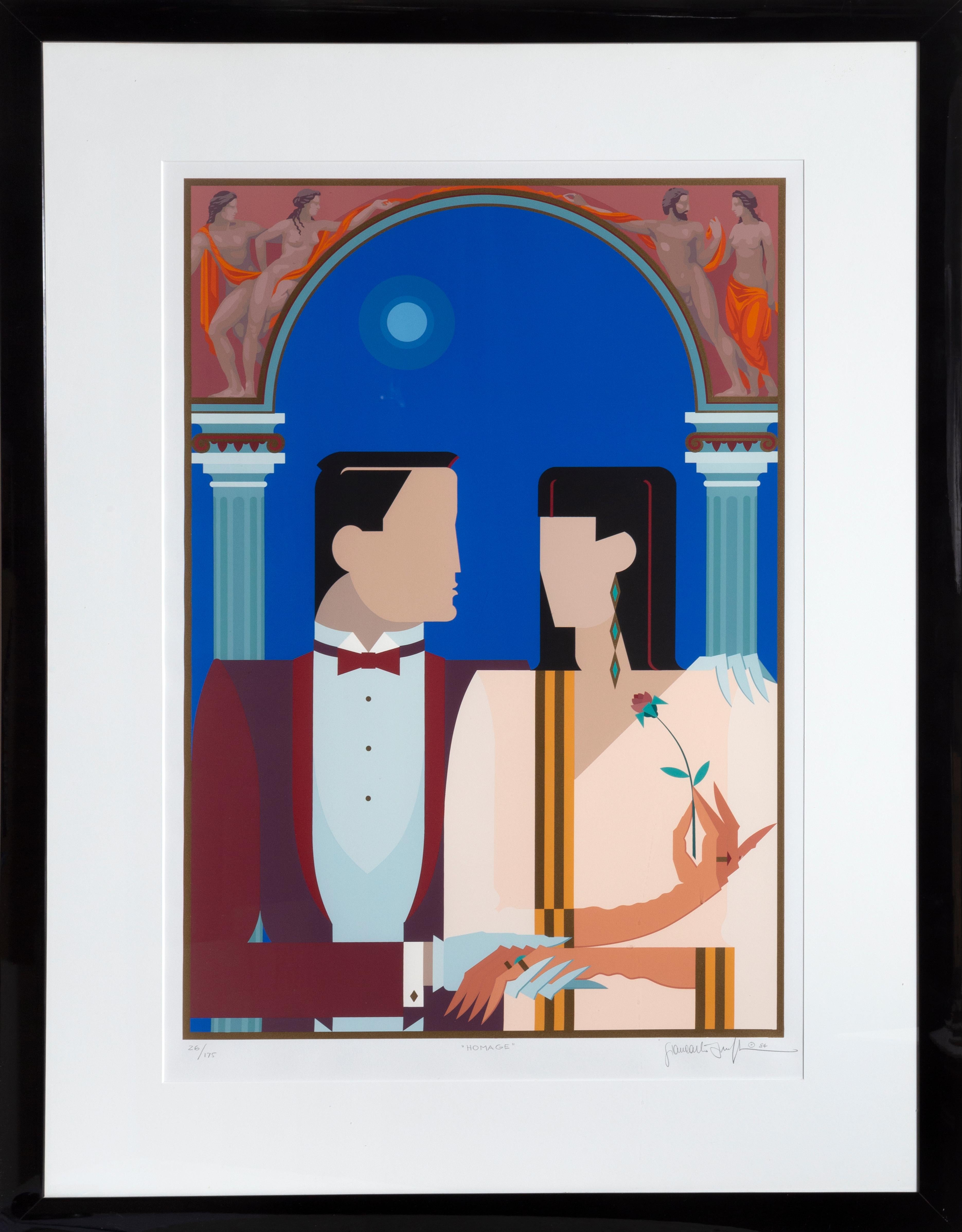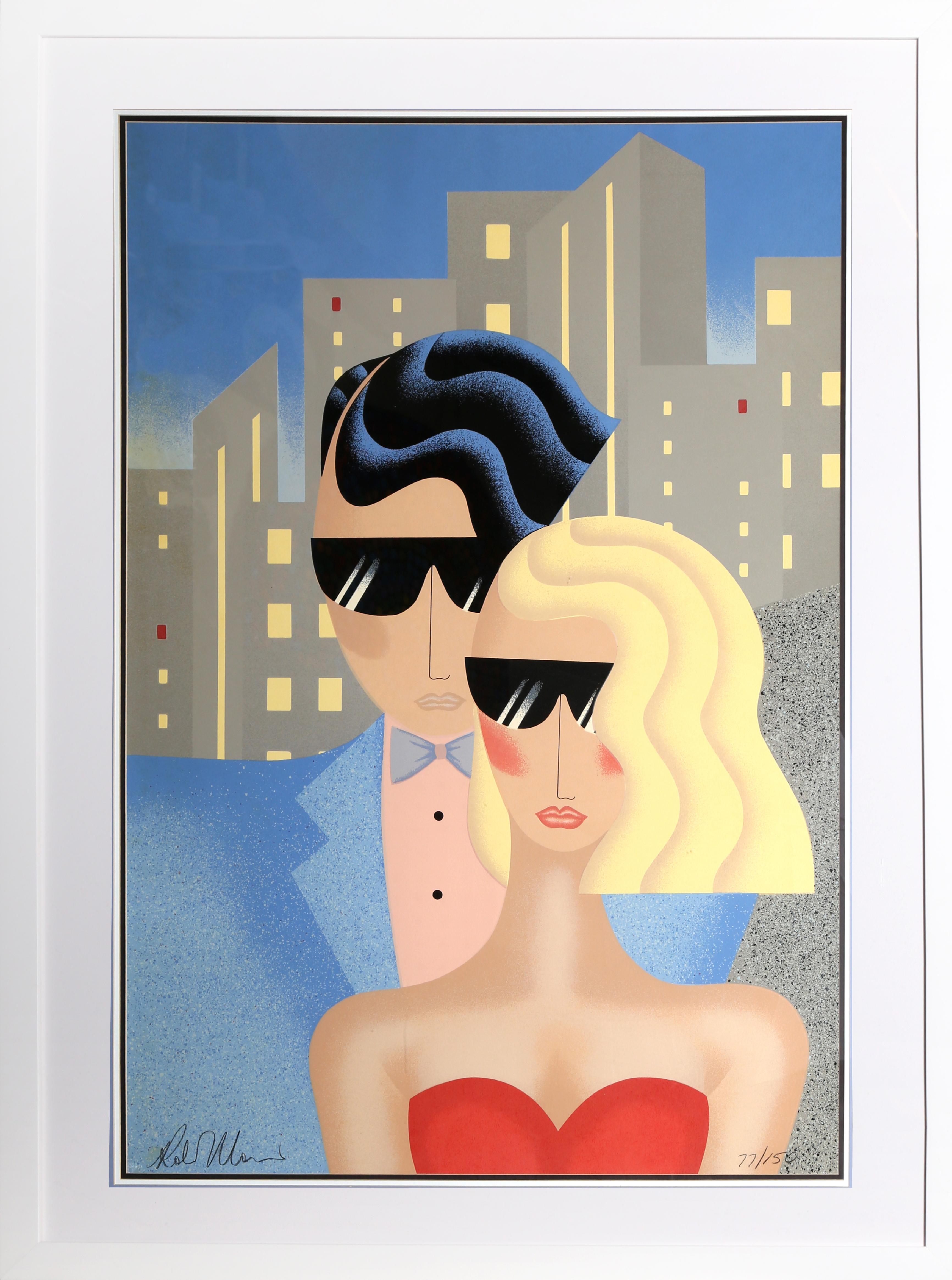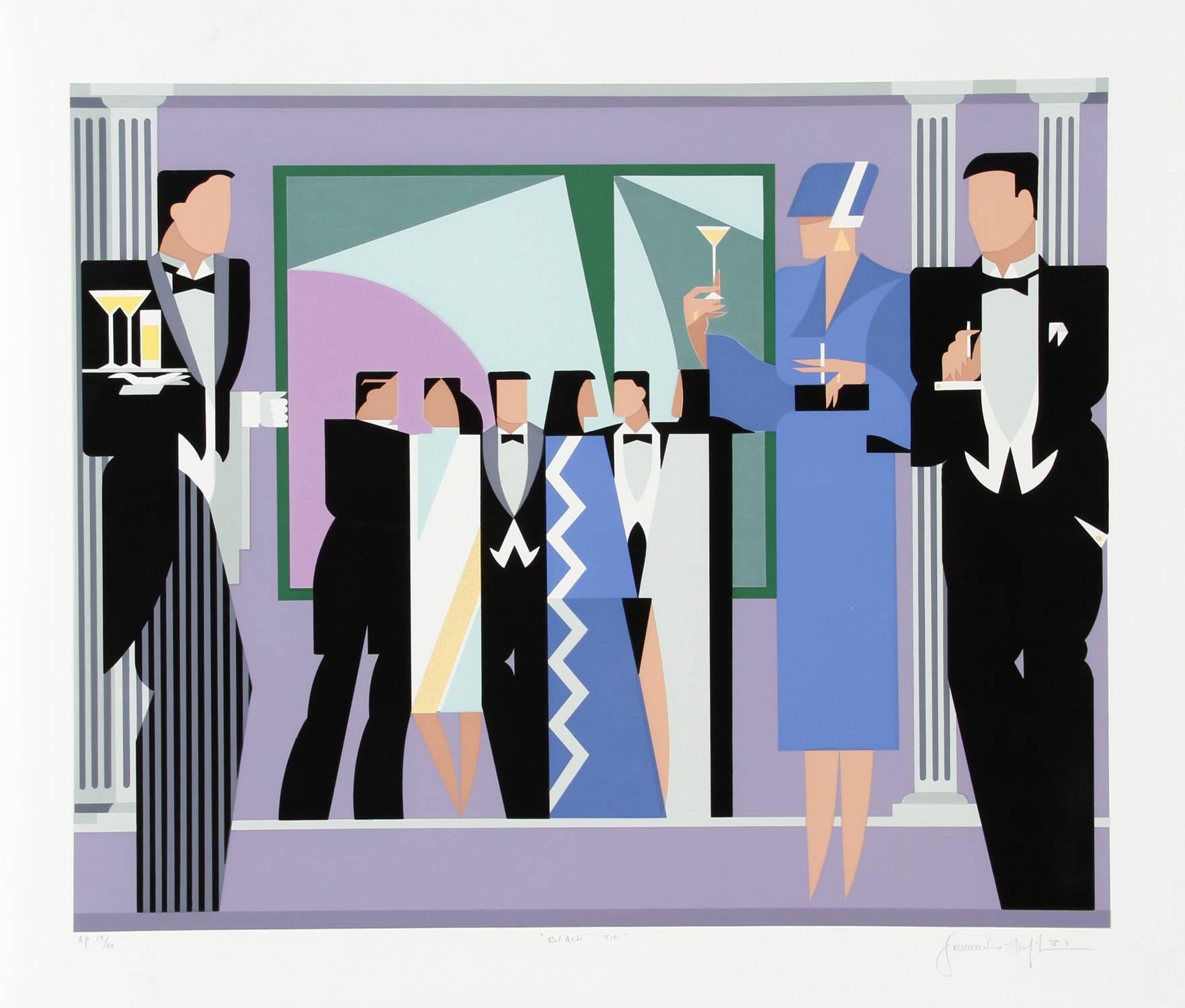ErtéMelisande at the Theatre, Art Deco Silkscreen by Erte1983
1983
About the Item
- Creator:Erté (1892 - 1990, Russian)
- Creation Year:1983
- Dimensions:Height: 37 in (93.98 cm)Width: 32 in (81.28 cm)
- Medium:
- Movement & Style:
- Period:
- Condition:
- Gallery Location:Long Island City, NY
- Reference Number:
Erté
Born Romain de Tirtoff (1892–1990) in St. Petersburg, Russia, to an aristocratic family, the artist known as Erté — a pseudonym derived from the French pronunciation of his initials — was a Renaissance man of the art and design world. He worked in graphic arts, interior design, fashion, jewelry and set design for the stage and silver screen, becoming a leader of the Art Deco style.
Moving to Paris in 1912, Erté worked as a fashion designer under couturier Paul Poiret before securing a job with Harper’s Bazaar as a cover artist. Over 22 years, Erté created more than 240 magazine covers alongside his ongoing work in fashion design.
Extending his prolific career into theater sets, costumes, prints and lithographs, Erté became one of the most famous artists of the era. His style — a combination of the nature-inspired flourishes of Art Nouveau and bold, geometric linework — directly contributed to the birth of Art Deco, earning him the nickname “the Father of Art Deco.”
After a lull of creative production in the 1940s and 1950s, Erté reentered the public eye in the 1960s, when a renewed interest in Art Deco had taken shape.
Creating colorful lithographs, bold serigraphs (silk-screen prints) and bronze sculptures, he contributed to a resurgence of the style in France and beyond. This late-life acclaim for his art led to exhibitions in museums and galleries all over the world as well as his first published monograph in 1970. That same year he was awarded the title of Chevalier du Mérite Artistique et Cultural and in 1976 was named Officier des Arts et Lettres by the French government.
Today, Erté’s works are in the collections of the Metropolitan Museum of Art and the Cooper Hewitt, Smithsonian Design Museum, in New York, the Victoria and Albert Museum in London and LACMA in Los Angeles.
On 1stDibs, browse a collection of Erté art, including fine art prints, paintings and other works.
- ShippingRetrieving quote...Ships From: Long Island City, NY
- Return PolicyA return for this item may be initiated within 7 days of delivery.
- Homage, Art Deco Screenprint by Giancarlo ImpigliaBy Giancarlo ImpigliaLocated in Long Island City, NYHomage Giancarlo Impiglia, Italian/American (1940) Date: 1984 Screenprint, signed and numbered in pencil Edition of 161/250 Size: 31.5 x 21.5 in. (80.01 x 54.61 cm) Frame Size: 40 x ...Category
1980s Art Deco Figurative Prints
MaterialsScreen
- Stepping Out, Art Deco Screenprint by Robin MorrisBy Robin MorrisLocated in Long Island City, NYStepping Out Robin Morris, American Screenprint, signed and numbered in pencil Edition of 77/150 Image Size: 45.5 x 31 inches Frame Size: 59 x 44 inchesCategory
1980s Art Deco Figurative Prints
MaterialsScreen
- Black Tie, Art Deco Screenprint by Giancarlo ImpigliaBy Giancarlo ImpigliaLocated in Long Island City, NYInspired by Cubism and Futurism, Giancarlo Impiglia’s print of a black tie affair is also reminiscent of Art Deco. With the sharp lines, lean physiques, and minimalistic approach to ...Category
1980s Art Deco Figurative Prints
MaterialsScreen
- Levrier (Italian Greyhound), Screenprint by Patrick NagelBy Patrick NagelLocated in Long Island City, NYLevrier (Italian Greyhound) by Patrick Nagel, American (1945–1984) Date: circa 1983 Screenprint, signed and numbered in pencil Edition of 25/300 Image Size: 33 x 25.5 inches Size: 40...Category
1980s Art Deco Figurative Prints
MaterialsScreen
- A Toast, Art Deco Serigraph by Giancarlo ImpigliaBy Giancarlo ImpigliaLocated in Long Island City, NYArtist: Giancarlo Impiglia Title: A Toast Year: 1981 Medium: Serigraph, signed and numbered in pencil Edition: 300, AP 40 Paper Size: 39 x 29 inchesCategory
1980s Art Deco Figurative Prints
MaterialsScreen
- The DanceBy Robin MorrisLocated in Long Island City, NYThe Dance Robin Morris, American Date: circa 1980 Screenprint, signed and numbered in pencil Edition of AP Size: 19.5 x 28.5 in. (49.53 x 72.39 cm) Frame Siz...Category
1980s Art Deco Figurative Prints
MaterialsScreen
- L’Allumage Moderne.Located in London, GBGAMY and MONTAUT, Ernest. L’Allumage Moderne. Magneto Lavalette Eisemann. [Paris: Mabileau & Co., c. 1910]. Hand-coloured pochoir print. Framed and glazed, overall size: 93.6cm x ...Category
1910s Art Deco Figurative Prints
MaterialsScreen, Stencil
- Enigma II, Figurative Artwork, Art Deco Art, Large Statement PrintBy Rosie EmersonLocated in Deddington, GBEnigma II’ (Edition 6/7)is a figurative hand painted screen-print with charcoal and metallic powders on Somerset Satin Print making Paper. Each print is unique. Discover new artworks...Category
2010s Art Deco Figurative Prints
MaterialsMetal
- Onyx CoiffureBy Erte - Romain de TirtoffLocated in Greenwich, CTOnyx Coiffure is an expertly crafted, embossed serigraph on paper with foil stamping and an image size of 27 x 22 inches. From the edition of 650, the art is numbered 214/300 and est...Category
20th Century Art Deco Prints and Multiples
MaterialsPaper, Screen
- Au JaponBy Victor Max NinonLocated in Fairlawn, OHAu Japon Pochoir (Stencil Print), 1925 Signed by the artist in pencil lower right (see photo) Signed in the image lower left (see photo) Stamped verso: Made in France Note: The artist won a gold medal in Paris in 1925 for his porchoirs Condition: excellent Image size: 11 1/2 x 13 inches Sheet size: 20 x 25 3/4 inches The artist is Italian, Vittorio Accornero de Testa, working in Paris. The image combines Art Deco and Japonism, two of the most famous styles of the period of the 1920's. Condition: Excellent, never matted or framed Victor Max Ninon (Vittorio Accornero de Testa, Italian, 1896-1982) Biography Vittorio Accornero de Testa was born in Casale Monferrato in 1896. He completed his first studies at the "Leardi" institute, but was forced to interrupt them due to the war events of the First World War . At 19 he was second lieutenant of the Alpine troops and in 1916 he took one of the first pilot's licenses. During the war he knows the bitterness of shooting down in air combat (for which he is decorated), but also the good fortune to stay alive, albeit with a disability. His art blossomed in the postwar period, first signing his works simply Ninon and then, probably at the suggestion of a French publisher, under the pseudonym of "Victor Max Ninon" (Victor and Max indicate strength and masculinity, Ninon boyhood) .In 1919 and 1924 he made illustrations for theGiornalino della Domenica , also together with his first wife Edina Altara , for Ardita and La Lettura . In 1923 he won the cover competition organized by the magazine El Hogar of Buenos Aires and in 1925 with his pochoirs he imposed himself in Paris at the international exhibition of modern decorative and industrial arts , obtaining a gold medal. In the same year he made two covers for the US magazine The Smart Set . In the 1920s he made numerous series of art deco style postcards for the Milanese publishing house Degami . On June 4, 1929, aGenoa embarks on the Conte Grande together with his wife Edina Altara , for New York . The two stayed in the American metropolis for a few months: in this period Accornero worked on the creation of theatrical sets and created some covers for Country Life magazine . Accornero gets awards and prizes, but the great economic crisis of the time and the nostalgia for Italy convince the two to return to their homeland, where they resume their activity as illustrators. In 1934 Accornero moved to Milan, separated amicably from his wife and continued to dedicate himself to the illustration of children's books, abandoning the pseudonym Victor Max Ninon. It illustrates about 60 books, from the fables of Andersen , Perrault and Grimm , to the tales of Poe , as well as the famous Pinocchio and Cuore published by Mondadori, Mursia, Hoepli, Martello. Several books illustrated by Accornero have been published in French, Spanish, German and English. In addition to the periodicals already mentioned, he collaborates on the first edition of the Encyclopedia of Boys , Mondadori, and with the Italian magazines Lidel , Il Secolo XX, The Italian Illustration , Fantasies of Italy , The Woman , Cordelia , For You Lady , Grace , Metropolis , La Domenica del Corriere , The Corriere dei Piccoli . In 1936 enters the world of cinema, creating sets and costumes for Wedding Vagabonde of Guido Brignone and The White Squadron of Augustus Genina . From 1935 to 1950 he also devoted himself to the theater, taking care of sets and costumes for numerous operettas, ballets and performances at the Scala in Milan and for the Milanese theaters Manzoni, Lirico and Olympia. Stages Marcello di Giordano, Nina pazza d'amore by Paisiello, I cantori di Nurimberga by Wagner, La Bohème by Puccini and other works. For this activity he is also cited in the Theater encyclopedia. In the 1940s and 1950s he wrote and illustrated six books for children for Mondadori: Tomaso (1944), Giacomino (1949), Tomaso Cacciatore (1950), Zio Stefano (1950), In Campagna che delizia! (1953), Tomaso, dear Tomaso (1955). His illustrations of Perrault's Tales published in those years by Hoepli are famous. His art in the fifties evolves towards hyperrealism . There are many personal exhibitions in Italy and abroad, including those at the Gallerie Gussoni (1959) and Bolzani (1963 and 1966) in Milan and Walcheturm (1962) in Zurich. Eminent critics praise his work, from Orio Vergani to Enrico Piceni, from Reto Roedel to De Chirico himself. On the Domenica del Corriere , the journalist, writer and painter Dino Buzzati...Category
1920s Art Deco Figurative Prints
MaterialsScreen
- En EspagneBy Victor Max NinonLocated in Fairlawn, OHEn Espagne Pochoir (silk screen) printed in colors Signed by the artist in pencil lower right The artist won a gold medal in Paris in 1925 for his pochoirs Condition: Excellent Image size: 11-1/2 x 13" Sheet size: 19 1/2 x 24 3/4"; The artist won a gold medal in Paris in 1925 for his porchoirs The artist is Italian, Vittorio Accornero de Testa, working in Paris. The image combines Art Deco and Japonism, two of the most famous styles of the period of the 1920's. Biography Vittorio Accornero de Testa was born in Casale Monferrato in 1896. He completed his first studies at the "Leardi" institute, but was forced to interrupt them due to the war events of the First World War . At 19 he was second lieutenant of the Alpine troops and in 1916 he took one of the first pilot's licenses. During the war he knows the bitterness of shooting down in air combat (for which he is decorated), but also the good fortune to stay alive, albeit with a disability. His art blossomed in the postwar period, first signing his works simply Ninon and then, probably at the suggestion of a French publisher, under the pseudonym of "Victor Max Ninon" (Victor and Max indicate strength and masculinity, Ninon boyhood) .In 1919 and 1924 he made illustrations for theGiornalino della Domenica , also together with his first wife Edina Altara , for Ardita and La Lettura . In 1923 he won the cover competition organized by the magazine El Hogar of Buenos Aires and in 1925 with his pochoirs he imposed himself in Paris at the international exhibition of modern decorative and industrial arts , obtaining a gold medal. In the same year he made two covers for the US magazine The Smart Set . In the 1920s he made numerous series of art deco style postcards for the Milanese publishing house Degami . On June 4, 1929, aGenoa embarks on the Conte Grande together with his wife Edina Altara , for New York . The two stayed in the American metropolis for a few months: in this period Accornero worked on the creation of theatrical sets and created some covers for Country Life magazine . Accornero gets awards and prizes, but the great economic crisis of the time and the nostalgia for Italy convince the two to return to their homeland, where they resume their activity as illustrators. In 1934 Accornero moved to Milan, separated amicably from his wife and continued to dedicate himself to the illustration of children's books, abandoning the pseudonym Victor Max Ninon. It illustrates about 60 books, from the fables of Andersen , Perrault and Grimm , to the tales of Poe , as well as the famous Pinocchio and Cuore published by Mondadori, Mursia, Hoepli, Martello. Several books illustrated by Accornero have been published in French, Spanish, German and English. In addition to the periodicals already mentioned, he collaborates on the first edition of the Encyclopedia of Boys , Mondadori, and with the Italian magazines Lidel , Il Secolo XX, The Italian Illustration , Fantasies of Italy , The Woman , Cordelia , For You Lady , Grace , Metropolis , La Domenica del Corriere , The Corriere dei Piccoli . In 1936 enters the world of cinema, creating sets and costumes for Wedding Vagabonde of Guido Brignone and The White Squadron of Augustus Genina . From 1935 to 1950 he also devoted himself to the theater, taking care of sets and costumes for numerous operettas, ballets and performances at the Scala in Milan and for the Milanese theaters Manzoni, Lirico and Olympia. Stages Marcello di Giordano, Nina pazza d'amore by Paisiello, I cantori di Nurimberga by Wagner, La Bohème by Puccini and other works. For this activity he is also cited in the Theater encyclopedia. In the 1940s and 1950s he wrote and illustrated six books for children for Mondadori: Tomaso (1944), Giacomino (1949), Tomaso Cacciatore (1950), Zio Stefano (1950), In Campagna che delizia! (1953), Tomaso, dear Tomaso (1955). His illustrations of Perrault's Tales published in those years by Hoepli are famous. His art in the fifties evolves towards hyperrealism . There are many personal exhibitions in Italy and abroad, including those at the Gallerie Gussoni (1959) and Bolzani (1963 and 1966) in Milan and Walcheturm (1962) in Zurich. Eminent critics praise his work, from Orio Vergani to Enrico Piceni, from Reto Roedel to De Chirico himself. On the Domenica del Corriere , the journalist, writer and painter Dino Buzzati...Category
1920s Art Deco Figurative Prints
MaterialsScreen
- LIBRABy ErtéLocated in Aventura, FLSerigraph in colors on paper. Hand signed and numbered by Erte. From the Zodiac Suite. Edition of 350. Frame size approx 32 x 26 inches. Artwork in excellent condition. Certifica...Category
1980s Art Deco Figurative Prints
MaterialsScreen, Paper
Recently Viewed
View AllRead More
Chryssa’s 1962 Neon Sculpture Was Way ahead of the Art-World Curve
By working with lettering, neon and Pop imagery, Chryssa pioneered several postmodern themes at a time when most male artists detested commercial mediums.
7 Exciting Works by Female Artists from the RoGallery Auction
Prints by these modern and contemporary visionaries are relatively affordable — for now.





